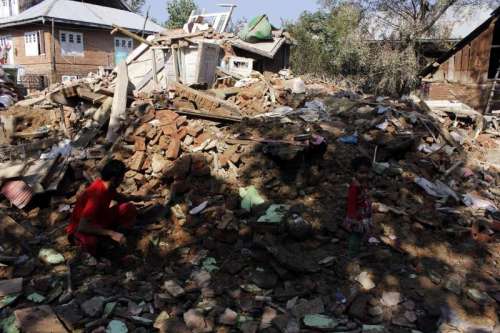
By Sheikh Qayoom
As they start gradually coming out of the shock caused by a devastating flood the likes of which Kashmir’s summer capital Srinagar had not seen even in 1893, the worst ever recorded so far, Kashmiris are now taking stock of their material losses.
Businesses have been shattered, agriculture has been devastated and families have been uprooted from their homes which might not be immediately livable, given the fact that winter is knocking at the Valley’s door. Two thousand houses have been completely destroyed in the Valley. More than 20,000 have suffered partial damage.
This does not include those in Srinagar city that bore the brunt of the floods.
Losses to agriculture are now officially estimated to have crossed Rs.3,500 crore (nearly $60 million). Trade and business losses in the city continue to be wild guess since most of the shops in the commercial hub of Residency Road, Lal Chowk, Badshan Chowk, Maisuma and Hari Singh High Street are still flooded.
The Kashmir Chamber of Commerce and Industry puts business and industrial losses at Rs.1 trillion.
Weeping and wailing shopkeepers in Badshah Chowk and other flooded areas were Tuesday cutting their iron shutters as these had rusted during the 10 days of floods and could not be opened normally.
“When I cut open the shutter of my shop, it seemed as if an explosion had occurred inside. Everything was smashed and smothered,”, said Nazir Ahmad, a shopkeeper in Badshah Chowk.
Experts say when flood waters entered the shops in inundated areas, huge pressure was built inside as the flood waters had no way to come out of locked shops and business establishments.
“This resulted in creation of tons of pressure that destroyed all merchandise, show windows, furnishings and furniture inside,” said a hydraulic engineer here.
Water-logged Maisuma is just on the other side of the Maulana Azad Road that leads to the civil secretariat from where the top state government offices function.
Maisuma has a large residential area and commercial establishments including shops and business offices.
“Everything is still under two feet of water as the fire brigade and police help the municipal authorities pump out the water from here,” said Shuja, 45, who has a shop in the area he hasn’t been able to open for the last 15 days.
The residential and commercial areas of Rajbagh, Jawahar Nagar, Wazir Bagh, Karan Nagar and Nursing Garh are still flooded.
The threat of an epidemic now looms over Srinagar’s 1.45 million population.
The authorities say they have removed more than 300 animal carcasses those were floating in the flood waters of the city.
Asked whether these buried carcasses wouldn’t trigger an epidemic in areas where the authorities had buried them, Chief Minister Omar Abdullah said: “We have treated these carcasses with chemicals before they were removed and buried. There is no danger of any epidemic in areas where these carcasses have been buried.”
The Srinagar Municipal Corporation faces an uphill task to ensure sanitation and check spread of infections in the flood-ravaged city.
There is a foul smell around the inundated areas. Everybody engaged in removal of garbage is wearing a mask. This covers policemen, municipal workers and relief distributors.
Doctors have advised people to boil water and keep it on the boil for at least 20 minutes so that it is safe for drinking.
“All the flood-triggered diseases are water-borne. If you are able to take care of your water, there is no threat of any epidemic in the city,” said the director of the state health department.
Even when the resilience of Kashmiris has historically been such that they have emerged stronger from earthquakes, famines and floods in the past, this biblical flood has shattered them deep down.
Nobody could have put it better than the chief minister himself: “Well, my government was drowned.”
Well, it took just one night to drown what was the pride of Srinagar, including its posh residential colonies, business centres and, most important of all, the confidence of its residents.